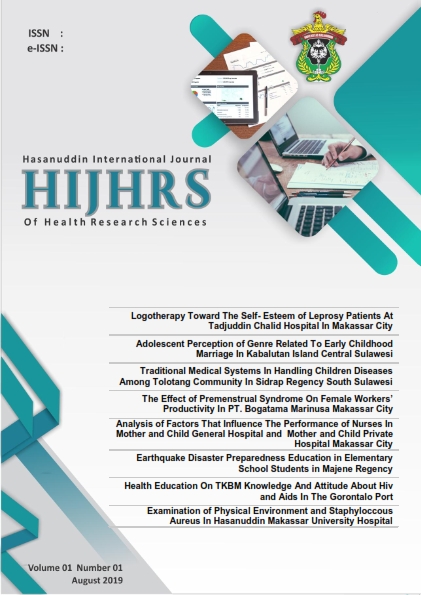THE RELATIONSHIP BETWEEN LEADERSHIP STYLE AND NURSE’S WORK MOTIVATION WITH THE APPLICATION OF PATIENT SAFETY CULTURE OF THE INPATIENT INSTALLATION IN THE C CLASS HOSPITAL, BONE REGENCY
Abstrak
In building patient safety culture, leadership is one of the behavioral factors in the Total Safety Culture model. The patient safety culture is related to the issue of Adverse Events as the main issue of this study. Beside that, active involvement of organization members is also needed in the form of work motivation. Therefore, this study aims to identify the dominant leadership style of the inpatient nurse managers in the c class hospitals and to analyze the relationship between the leadership style and nurse’s work motivation with the application of patient safety culture in the c class hospitals of Bone regency. This research is a cross sectional study with 104 samples of nurses providing care, taken in total sampling at three hospitals, namely Datu Pancaitana Regional Hospital, M. Yasin Army Hospital, and Hapsah Hospital. Data were collected using a structured questionnaire and statistically analyzed using the chi-square test (k x k). The results of this study indicate that the dominant leadership style of the inpatient nurse managers is transactional with the percentage of 69.2%. The results also showed that there was a relationship between leadership style (p <0.05) and nurse’s work motivation (p <0.05) with the application of patient safety culture. It was concluded that the transactional leadership had a positive impact in building an independent culture. The combination of extrinsic and intrinsic motivation has succeeded in creating a public service motivation that has a positive impact in building a reporting and learning culture.Unduhan
Referensi
Alghazo A.M. & Al-Anazi M. (2016). The Impact of Leadership Style on Employee’s Motivation. International Journal of Economics and Business Administration, 2(5):37–44.
Antonakis J., Avolio B.J., Sivasubramaniam M. (2003). Context and Leadership: An Examination of the Nine-Factor Full-Range Leadership Theory Using the Multifactor Leadership Questionnaire. The Leadership Quarterly 14(2003):261–295.
Boamah S.A., Laschinger H.K.S., Wong C. & Clarke S. (2017). Effect of transformational leadership on job satisfaction and patient safety outcomes. Nursing Outlook 66(2):180-189.
Chowdhury R.G. (2014). A Study on The Impact of Leadership Styles on Employee Motivation and Commitment: An Empirical Study of Selected Organisations in Corporate Sector (Dissertation). Navi Mumbai : Padmashree Dr D. Y. Patil University.
Danielsson M. & Nilsen P. (2017). A National Study of Patient Safety Culture in Hospitals in Sweden.J Patient Saf, 0(0):1–6.
Ernur M.M. & Marhadi M. (2014). Pengaruh pelatihan, kompensasi, dan pengembangan karir terhadap kinerja karyawan bagian penjualan dengan motivasi sebagai variabel mediasi pada PT Gulang Medica Indah, Pekanbaru. JOM FEKON, 1(2):1-17.
Fischer S.A. (2016). Transformational leadership in nursing : a concept analysis. J Adv Nurs., 72(11):2644–2653.
Giddens J. (2017). Transformational leadership : what every nursing dean should know. Journal of Professional Nursing 34(2):117-121.
Guntoro B., Hastuti D.W. & Nurtini S. (2016). The Relationship Between Leadership Type , Work Motivation , Training of Employee , and Physical Work Environment Toward Employee ’ s Performance of Fastfood Company in Yogyakarta Indonesia. Global Advanced Research Journals, 5(1):18–25.
Hayati D., Charkhabi M. & Naami A. (2014). The relationship between transformational leadership and work engagement in governmental hospitals nurses : a survey study. SpringerPlus, 3(25):1–7.
Jensen U.T. & Bro L.L. (2017). How Transformational Leadership Supports Intrinsic Motivation and Public Service Motivation : The Mediating Role of Basic Need Satisfaction. American Review of Public Administration, 48(6):535-549.
Khanzada B., Naeem S. & Butt H. (2018). Impact of Transformational Leadership on Job Satisfaction and Patient Safety Outcomes in Health Sector of Pakistan. J Health Edu Res Dev, 6(2):251.
McRae S.L. (2017). Transforming Leadership for Patient Satisfaction. Nurs Manage., 48(2):51-54
Merrill K.C. (2015). Leadership Style and Patient Safety Implications for Nurse Managers. J Nurs Adm, 45(6):319-24.
Musinguzi C., Namale L., Rutebemberwa E., Dahal A., Nahirya-Ntege P. & Kekitiinwa A. (2018). The Relationship Between Leadership Style And Health Worker Motivation, Job Satisfaction And Teamwork In Uganda. Journal of Healthcare Leadership, 10:21—32.
Paradiso L.A. & Sweeney N. (2017). The Relationship Between Just Culture, Trust, and Patient Safety (Dissertation). New York : New York City College of Technology.
Ryan R.M. & Deci E.L. (2000). Self determination theory and the facilitation of intrinsic motivation, social development, and well-being. American Psychological Association, Inc., 55(1):68-78.
Vierendeels G., Reniers G., van Nunen K., Ponnet K. (2018). An integrative conceptual framework for safety culture: The Egg Aggregated Model (TEAM) of safety culture. Safety Science, 103:323–339.
Veliu L., Manxhari M., Demiri V. & Jahaj L. (2017). The Influence of Leadership Styles on Employee’s Performance. Vadyba Journal of Management, 31(2):59–69.
Wijono S. (2018). Kepemimpinan Dalam Perspektif Organisasi. Jakarta: Prenadamedia Group.
Zetter S., Çaylak M. & Sebahattin T. (2013). The Motivation of Hospital Staff Members: an Implementation in Antalya Province. International Journal of Social Sciences, 8(1): 64–75.
##submission.downloads##
Diterbitkan
Terbitan
Bagian
Lisensi



